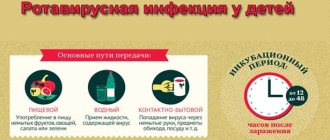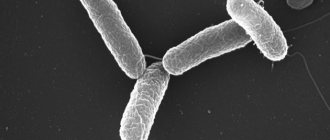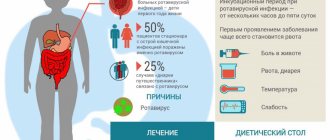According to statistics, in half of the cases of hospitalization of young children with signs of acute intestinal diseases, the cause is rotavirus enteritis. The problem is especially relevant for children under the age of about five years, who get sick more often than other age groups and have difficulty coping with the disease. The disease is dangerous because it can lead to dehydration due to severe vomiting, diarrhea and fever.
To protect babies, special vaccines have been developed, one of which, Rotatek, is successfully used all over the world. This is what is used at the Gorbakov Clinic for vaccination against rotavirus.
Vaccine options
Current vaccines are based on the production of live attenuated strains of rotavirus of human and/or animal origin that multiply in the human intestine.
There are two rotavirus vaccines on the international market: monovalent (RV1 - Rotarix) and pentavalent (RV5 - RotaTek). The RV1 vaccine is based on a human strain, while the RV5 vaccine contains 5 recombinant viruses based on human and bovine strains. In Russia, the RotaTek vaccine (pentavalent RV5) is used - it is oral and contains 5 recombinants of rotaviruses obtained from human and bovine parent strains of the virus. The interchangeability of RV1 and RV5 vaccines has not been studied.
Vaccine composition
The drug "Rotatek" is produced by the American corporation "Merck Sharp and Dome" in the Netherlands. It contains live cultures of rotaviruses of five different subtypes, as well as safe excipients necessary to maintain the functionality of microorganisms.
The above-mentioned vaccine is produced through genetic engineering. It is based on a combined rotavirus, which contains sections of the genome that provoke an optimal immune response. This approach makes it possible to obtain high protection against viruses, since the latter regularly change their antigenic structure due to variability.
Principles and purposes of vaccination
Rotaviruses infect almost every child before they reach the age of 3-5 years and are the world's leading cause of severe diarrhea with dehydration in children aged 3-5 years. Every year in the period before the introduction of the vaccine (1986-2000), more than 2 million children around the world were hospitalized for rotavirus infection. WHO estimates that in 2008 there were approximately 453 000 (420 000 – 494 000) deaths among children associated with rotavirus gastroenteritis (RVGE) worldwide.
Currently, there is no specific therapy for rotavirus infection. WHO recommends that rotavirus vaccines should be included in national immunization programs and considered as a priority, especially in countries with high mortality rates associated with RVGE, such as countries in South and Southeast Asia and sub-Saharan Africa. The use of rotavirus vaccines should be a component of a comprehensive strategy to control diarrheal diseases. By the end of 2013, rotavirus vaccine had been introduced in 52 countries, and vaccine coverage had reached 14%.
The first dose of rotavirus vaccine, according to WHO recommendations, should be administered as early as possible - when the child reaches 6 weeks of age. The RV1 vaccine must be given twice, and the RV5 vaccine must be given three times. Both vaccines are given orally, with at least 4 weeks between doses. The RotaTek vaccine can be administered on the same day with any other vaccines (DPT, inactivated polio vaccine, vaccines against Haemophilus influenzae and pneumococcal infections, etc.) except oral live polio vaccine.
How is vaccination performed?
The timing of vaccination is determined by the pediatrician individually, since this vaccination is not included in the Calendar. Professor Gorbakov’s Clinic adheres to the recommendations from the instructions, so immunization is most often structured according to the following scheme:
- between six and twelve weeks of age, the baby receives the first dose;
- the recommended interval between vaccinations is from four to ten weeks;
- to form long-lasting immunity, the vaccine must be administered three times in a row - up to 8 months of age;
- In the case of this virus, revaccination is not necessary.
It is most convenient to combine immunization against rotavirus with routine vaccinations at three, four and a half and six months. If there is a need for early protection against rotavirus, the timing can be shortened: 6, 14, 22 weeks. It is not advisable to administer the first dose after 15 weeks of birth. However, if this happens, in the future it is worth reducing the interval to a minimum of four weeks.
Vaccine effectiveness
WHO recommends preventive vaccination as an effective remedy against rotavirus. Current vaccines demonstrate 80–90% effectiveness against severe rotavirus gastroenteritis (RVGE) in countries with very low or low mortality rates in children and adults, and 40–60% effectiveness in countries with high mortality rates in children and adults. high or very high mortality rates among adults. In developed countries, a decrease in the incidence of RVGE was observed several years after immunization. In Mexico and Brazil, vaccination resulted in a 22% to 28% reduction in diarrhea-related deaths among children 2 years of age and younger.
In most cases, vaccination in infancy provides protection against severe RVGE for at least 2 years (the period of greatest risk).
Infants can receive rotavirus vaccine along with DTP, regardless of the time of vaccination. Rotavirus vaccinations for children over 2 years of age are not considered inappropriate. Rotavirus vaccines may be given at the same time as other routine childhood vaccines except live oral polio vaccine.
Rotavirus infection: vaccination in Moscow
In the summer of 2014, vaccination of children from 1.5 to 8 months against rotavirus infection began in Moscow. Many parents are perplexed: another vaccination, and at such an early age - why is it needed? We collected the main myths about rotavirus and, with the help of experts, found out how it threatens children.
Myth 1. Rotavirus infection is diarrhea and vomiting, unpleasant, but passes quickly
Yes, this is approximately how the disease progresses in adults - it is also called “intestinal flu”. However, the majority of those sick are children in the first years of life; adults get sick 10 times less often. Almost every child, upon reaching 3-5 years of age, experiences rotavirus infection (RVI). 1 in 5 sees a doctor, 1 in 65 needs hospitalization, approximately 1 in 293 die.
The biggest danger of any intestinal infection and rotavirus in particular is loss of fluid from the body. Rotavirus attacks the intestinal cells, which reduces its ability to break down and absorb nutrients and develops diarrhea (diarrhea). In children under 2 years of age, fluid loss with diarrhea and vomiting occurs very quickly, and if the child is not given a special saline solution, he or she is at risk of dehydration, which can lead to cerebral edema.
According to WHO expert Professor Vladimir Tatochenko, half of sick children can be given water under the supervision of a doctor, but the rest require a dropper to maintain water and electrolyte balance in the body. “The lethality of RVI today depends entirely on the level and availability of medical care,” confirms Alexey Rtishchev, chief freelance specialist in infectious diseases in children in the Central Administrative District of Moscow.
Most often, children from 6 to 12 months who are bottle-fed get sick: their intestines are more vulnerable due to this type of nutrition, and they do not receive immune support from mother's milk.
The disease begins acutely - with fever and vomiting, and then diarrhea appears, which usually lasts 3-7 days. Here are data on symptoms in children 6 months to 3 years of age hospitalized with rotavirus infection:
- stool up to 10-15 times a day;
- vomiting within 2-3 days - in 78.9%;
- temperature above 38.5ºС - in 68.3%;
- catarrhal manifestations of the upper respiratory tract, which persisted for 3-4 days - in 81.2% of children.
(According to the Research Institute of Childhood Infections of the Federal Medical and Biological Agency.)
Myth 2. Rotavirus is a disease of dirty hands; if you follow the rules of hygiene, it is not dangerous
Indeed, rotavirus causes a disease in the form of acute intestinal infection (AEI), but unlike other pathogens of AEI, it is extremely contagious, and ordinary hygiene measures are ineffective against it.
The main route of spread of rotavirus is fecal-oral, directly from person to person or through contaminated objects. Infection through food and water is also possible, as for other intestinal infections, as well as through airborne droplets.
Transmission of the virus is possible before and after the onset of symptoms of the disease, as well as from asymptomatic patients. Infected people shed large amounts of viral particles in their stool: this begins 2 days before symptoms appear and can last up to 2 months after symptoms of the disease have resolved.
Who can you ask for your preliminary diagnosis? Changes in temperature, blood pressure, dizziness, weakness - these symptoms can occur in various diseases. A general practitioner can assist in establishing a diagnosis for a patient.
It's no surprise that babies who are just starting to crawl and walk are most at risk because they put everything in their mouths. Adults caring for sick children are also susceptible to the disease.
Rotavirus can survive in low humidity conditions, including on smooth surfaces; it is relatively resistant to hand soap and common disinfectants (only concentrated solutions of alcohol, chlorine, and iodine affect rotavirus). Experts do not exclude the spread of rotavirus through a contaminated water supply system, as well as through contaminated food in public catering areas.
According to Professor Leila Namazova-Baranova, director of the Research Institute of Preventive Pediatrics and Rehabilitation Treatment of the Scientific Center for Children's Health, one of the most “infectious” places is children's hospitals. 27-30% of young French and American children become ill with rotavirus infection during treatment in children's hospitals for other diseases. 70% of children hospitalized at the Scientific Center for Children's Health with rotavirus had previously been in other children's hospitals, where the infection occurred.
Studies have confirmed that the prevalence of rotavirus infection in countries with high and low levels of sanitary and hygienic conditions is the same. Because rotaviruses actively circulate in developed countries where clean water is widely available, it is believed that hygiene measures alone are not sufficient to defeat rotavirus.
Of course, you need to wash your hands. But if you are raising a child not in a secluded place, visit a children's clinic, go to developmental classes and are going to take your child to kindergarten, the chance of encountering rotavirus is quite high.
Myth 3. If it is a virus, then immunity should remain after illness
Rotavirus, discovered in 1973 and named for its round shape (from “rota” - wheel, Latin), has many varieties - serotypes. Immunity acquired after an illness caused by one serotype does not protect against others, so you can get rotavirus infection several times. There is evidence that, having had RVI twice, a person acquires immunity, but no full-fledged studies have been conducted on this matter.
Today it is known that acquired immunity after vaccination against rotavirus lasts 5 years (possibly longer, but the vaccine was released only in 2009, and there is no data for a longer study yet).
Myth 4. Vaccination against rotavirus is for epidemic indications. But there is no epidemic, which means there is no need to create one
This is what Professor Irina Lytkina, deputy, explained to us. Chief Physician of the City Consultative and Diagnostic Center for Specific Immunoprophylaxis. The national vaccination calendar of the Russian Federation includes vaccination, which is given to all children in Russia free of charge, at the expense of the federal budget. The national calendar for epidemic indications contains vaccinations, the decision on which is made by regional authorities depending on the epidemic situation. Such vaccination is carried out at the expense of the budget of the subject of the federation.
In Moscow, the situation with rotavirus is not the worst (48.7 cases per 100 thousand population, among children under 17 years old - 188.93 cases per 100 thousand population), but its incidence is growing by about 3.5% annually. Therefore, a decision was made to vaccinate Moscow children in the first six months of life against rotavirus infection. All children's clinics have already received the required amount of vaccine and recommendations for its use. Perhaps, after a while, Moscow’s experience will be able to be extended to other regions of the Russian Federation.
Myth 5. A child is constantly vaccinated in the first six months of life. Too much stress on the immune system
Vaccination against rotavirus is now included in the national vaccination calendars of 69 countries around the world. In many of them, the incidence of RVI has significantly decreased. Thus, in the USA, two years after the introduction of routine vaccination, rotavirus decreased by 85-94%. After the introduction of vaccination in Mexico and Brazil, mortality from acute intestinal infections decreased by 22-41%. However, no post-vaccination complications were identified.
According to the observations of pediatricians, Moscow children vaccinated this summer avoided intestinal infections at resorts in Bulgaria, where cases of such diseases are the rule rather than the exception for almost all children on vacation.
The vaccine against rotavirus is oral, instilled into the child's mouth. The timing of vaccination is calculated on the basis of completing prevention before the peak incidence of RVI, which occurs in 6-12 months. The first vaccination is recommended at 2 months (together with the pneumococcal vaccine), the second at 3 months (together with DTP), the third at 4.5 months (together with DPT).
Alexandra Fedorova
Author's article
Contraindications
The main contraindications for vaccination against rotavirus infection are a severe allergic reaction to the previous dose and severe immunodeficiency. Cautions for the use of rotavirus vaccine include a history of intussusception or intestinal malformations, chronic gastrointestinal diseases, and acute severe illness. Vaccination should be postponed if the child has acute gastroenteritis or fever due to severe or moderate illness.
Effectiveness of vaccination
After three administrations, Rotatek forms immunity in the child during the most critical period - up to about five years. Like other vaccines, it does not provide 100% guarantee and protection, but it seriously facilitates the process of intestinal flu and significantly reduces the likelihood of serious complications.
After administration, the child’s body develops protection against all G-serotypes of the virus, including those that are not included in the drug. During the first season, the effectiveness of the immune response to severe rotavirus reaches 97%, and during the next two it is about 70%.
A high-quality and safe genetically engineered vaccine called “Rotatek” is easily tolerated by the body of a small child and forms stable protection. At the Gorbakov Clinic, vaccination is carried out under the supervision of experienced pediatricians, and upon completion, parents receive qualified recommendations and answers to any questions.
Vaccination scheme
Three doses of the vaccine are administered. The first dose of the RotaTek vaccine should be administered as soon as possible after the child reaches the age of 1.5 months (6 weeks). Subsequent doses are given 4 to 10 weeks apart, with the final dose of vaccine given before the child reaches 32 weeks (8 months) of age.
Standard recommended RotaTek vaccination schedule: 2-3-4.5 months.
The RotaTek vaccine can be used in premature babies born at at least 25 weeks of gestation. The vaccine should be administered to such children no earlier than 6 weeks after birth.
Who produces Rotatek and what is known about it?
The manufacturer of the drug is the American company Merck&Co, Inc. It has undergone extensive testing and was approved by the FDA in 2006. The trial data is publicly available: it involved more than 71,000 children, it was a randomized, placebo-controlled trial that strictly complied with all the principles of evidence-based medicine.
There are other similar vaccines from other manufacturers in the world, but there is no clinical data on their interchangeability (unlike, for example, whooping cough-diphtheria-tetanus vaccines). Therefore, it is recommended to do the entire course of vaccination with the same drug that was in the first dose the baby received.










